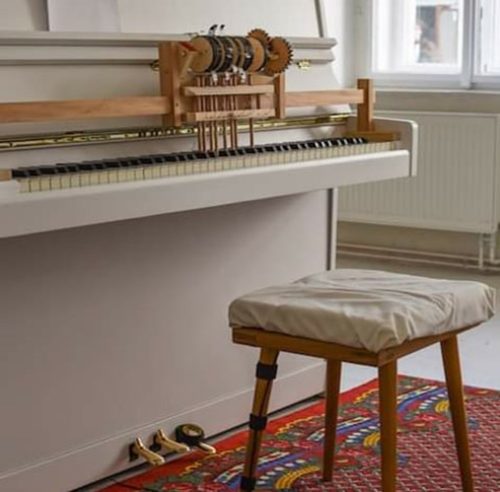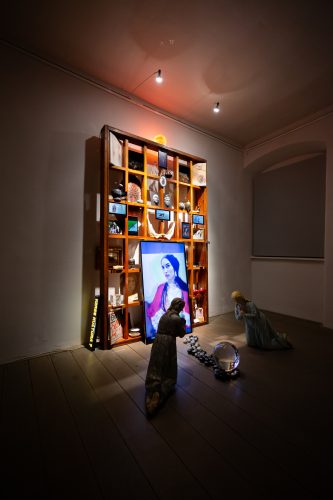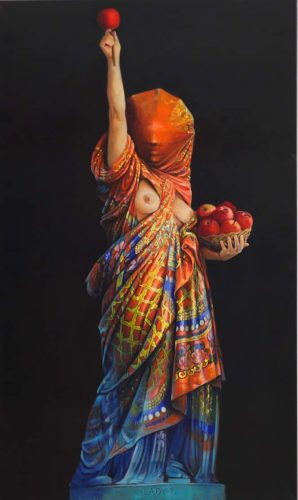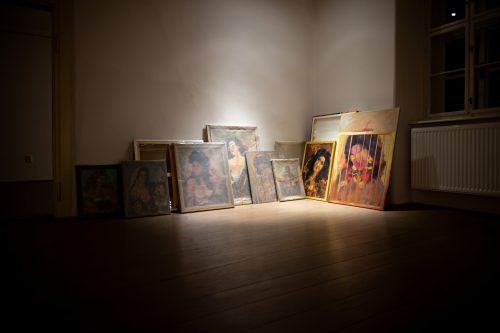Blackness in the Absent Body: On the Work and Artistic Career of Emília Rigová

Installation view: The Witch from The Coney Island exhibition, Bratislava, 2020 Photo: Martin Marenčin
There are certain key impulses that inspire the work that the Slovak-Roma artist Emília Rigová (*1980) has produced up till now, and which guide her creative trajectory. First and most crucial is the emergence of her alter ego, Bári Raklóri (bári = big, raklóri = daughter of non-Roma parents), which has become a leitmotif of her visual work over the past decade. For the artist, this pseudonym or second self serves as a kind of “identikit”: an individual narrative of rootedness, through which she conveys her personal experience, complemented by a broader knowledge and thinking of Roma identity and culture. She herself comes from an assimilated family, where cultivation of the Roma language as a basis of cultural affiliation ceased some generations before. The figure of Bári Raklóri is thus, above all, a personified cultural archaeology of her own borderland identity (between being Roma and not being Roma), and also of kinship and ethnic affiliation in the context of current discourses on post-colonialism. For Emília Rigová as Bári Raklóri, what this involved was literally a solitary coming out as Roma. This identity became a space for her self-reflection and self-knowledge, through the wider contexts and critical revision of Roma-ness today – its perception and status in Western society, and its historical, cultural and institutional background.
Within this context, Rigová first produced an eponymous collection of paintings in 2012, digitally mastered self-portraits. The series represents a sharp criticism of a stereotype: the view of the Roma woman as an erotic object, a bewitching “Bárinka” who reads cards to tell fortunes. In the visual mode of seemingly naïve paintings, Rigová emphasises the majority perspective, which she deconstructs in a manner both sophisticated and subversive. At the same time, her point of departure is (post-)feminist, alluding to aspects of her own identity as a young woman: an educated intellectual, artist and feminist. Within the medium of the hung painting, the self-portrait genre communicates a certain memorial context for how the works are read. They encode the format of the picture gallery and hence a historical sediment of perception of the Roma by the majority society. With a style that is likewise naïve, and apparently “unprofessional”, these paintings represent a widespread view of Roma art and culture as almost entirely uncultivated. Rigová turns this stereotyped gaze completely around and visualises how it is to be a Roma amidst a society full of prejudice and abiding racism, while also being culturally and socially marginalised. Urgently she poses the question: to what extent do we truly know Roma culture, and how do we perceive it? Can education, academic background and positive personal example be an instrument of real change?

Emília Rigová: Bári Raklóri, 2012, digital painting. Photo courtesy of the artist.
Emília Rigová: Depo/Auction, 2020, site-specific installation. Photo courtesy of the artist.
The politically committed subtext of Rigová’s artistic programme was appreciated by the international jury of the Oskár Čepan Award, the competition for young visual artists whose laureate she became in late 2018. And indeed, one may identify this moment as another of the essential impulses that have predetermined her later career – especially, in this case, her rocket-like start on the international art scene. At the exhibition of competition finalists held in Bratislava (curator: Lucia Gregorová Stach), Rigová was represented in a spectrum of contemporary media, from the manipulated photograph, through the artist’s video performance, to the object and installation. With the aim of deconstructing stereotypes and raising sensitivity, in certain works she accentuated those iconic elements and symbols which the majority traditionally associates with Roma society: gold and golden colour, passionate and uninhibited red, dark (black) skin colour, generally a cultural orientalism, a showy variety to the point of kitschiness, a certain exoticism, and needless to say, naïveté. Examples include the thought-provoking performative act of vomiting liquid gold in the video, Vomite ergo sum! (2018), and the motley-coloured floral redesign of the object of a heavy protective vest, Bulletproof Culture (2018), which was subsequently acquired by the Slovak National Gallery’s collection. Already in these works, the artist was subliminally advancing the theme of woman – Roma to wider contexts of Roma corporality, along the lines of ideas exploring the concept of blackness.

Oskár Čepan Award, Time After Time exhibition, installation view, Bratislava, 2018. Photo: Adam Šakový

Oskár Čepan Award, Time After Time exhibition, installation view, Bratislava, 2018. Photo: Adam Šakový
A solo exhibition followed in the spring of 2020, entitled Čohani z Koni Ajlend. After Bári Raklóri (The Witch from Coney Island: After Bári Raklóri, curator: Nina Vrbanová), in the renowned window gallery of Kunsthalle LAB in Bratislava. Rigová conceived the exhibition space as a paradoxical display of paintings that evoked a non-existent museum of Roma art and culture. She expressed the absence of such an institution, and the need for it, firstly via a complex spatial solution à la picture gallery (architect: Peter Liška), but simultaneously with a strategy of individual oil paintings whose “manufacture” she had commissioned. The paintings represent a transcription and critical interpretation of selected works of European and American art, with reference to the invisible history of the Roma. The format of the museum of art, as assumed by her paradoxical “display” of paintings, thus encompassed a critical revision of the Western history of art and culture. Inspiration for the exhibition’s theme and context came from the artist’s residency in New York, which transposed the accent on Roma culture and history specifically into an American pop culture setting. Lady L. (2020) shows the Statue of Liberty in a radical feminist guise, swathed in a decorative Roma scarf. Other familiar images of Western history are manipulated likewise, so as to declare the invisibility of Roma culture in history (e.g., The Boilerman’s Daughter Bakes Apples, 2020).

The Witch from Coney Island exhibition, installation view, Bratislava, 2020. Photo: Martin Marenčin

The Witch from Coney Island exhibition, installation view, Bratislava, 2020. Photo: Martin Marenčin
Rigová’s work draws upon academic knowledge to a notable extent. She makes use of the etymology of the Roma language, fuses contexts from art history as the visual representation of historical memory, and employs elements of cultural archaeology while researching and thinking about Roma-ness as her own identity. From the viewers of her works, she expects empathy and an interest in this knowledge, which she encodes in the language of contemporary art. Knowledge, acceptance and sensitivity towards minority culture are the essential aim and meaning of her art. Indeed, besides her career in visual art, Rigová is involved in numerous activities connected with education, raising visibility and socio-cultural research of the Roma minority (not only in Slovakia). The most significant example is the establishment and operation of the Cabinet of Roma Art and Culture at Matej Bel University in Banská Bystrica on her personal initiative (2019). In collaboration with the art historian Petra Hanáková, currently she is also developing an exhibition of Roma art, Phundrado drom (Open Road), as a curators’ selection from the collection (visual fund) of the Museum of Roma Culture in Brno, which will be presented in 2022 in the spaces of Prague’s Musaion – Kinský Summer Palace. With this in mind, when Rigová and her co-workers (whether in the contemporary art milieu or in academia) strive to create the supporting pillars for the knowledge and development of Roma culture, one can distinguish the activist spirit in her work. Just as, for instance, “women’s art”, feminism and the queer agenda have attained their emancipation in terms of art history and theory, so equally artists with Roma roots are treading this path today – seeking in thinking, visibility, humanisation, acceptance in the field of professional art.
The pandemic situation over the past two years has caused no interruption in Rigová’s artistic career. Quite to the contrary, it “booted” her in a new direction. She has been continuously engaged in her visual art and, where the situation permitted, in exhibitions. Most likely the first project foreshadowing her future path was the 2020 exhibition in the Artivist Lab in Prague, entitled Revive / Purano Hangos (Revival of Old Voices, curator: Tamara Moyzes). Her main source of inspiration for this was newly-discovered written music of old, long-forgotten Roma songs. The anthropology of Roma music culture, in an evocative symbolism of the absent body, is also the starting point for her upcoming exhibition in the renowned MUMOK in Vienna, to be held in the autumn of 2022 (curator: Rainer Fuchs). As a complex environment, the identity of female Roma blackness becomes more sophisticated and heightens its tempo. Again, we discover a kind of auto-revision of the work hitherto, linked with an ambitious quest for new expression and ways forward, in the “mini-retrospective”, Kale bala parno muj (White Mouth, Black Hair, curator: Petra Hanáková), which the artist also presented in 2020, in Schemnitz Gallery in Banská Štiavnica. It was here for the first time that she presented the architecturally fashioned installation, altaRIG (2020), with the oppressive themes of exclusion and peripherality of the Roma throughout history, towering against the background of her personal mythology. This work will be the centrepiece of her presentation at this year’s Triennale of Art in Milan (curator: Timea Junghaus).

Revival of Old Voices exhibition, installation view, Prague, 2020. Photo courtesy of the artist.

Emília Rigová: altaRIG, 2020, multimedia installation. Photo courtesy of the artist.
At this stage, the third key impulse in Emília Rigová’s art and career would appear to be the fulfilment of Bári Raklóri as the artist’s alter ego, its abandonment, and the turn towards the visual code of the absent body. Now, more than ever before, the international art scene, its institutional platforms and theoretical discourse, are evidently prepared for the themes of the Roma diaspora and transnational identity. (Paradoxically so, since in present-day Europe, we see a variety of nationalisms and new waves of xenophobia increasingly often.) And this is indeed the authentic path and probably the future “homeland” of this visual artist, whose personal identity and courage resonate with the striving for an inclusive global society on all levels. Revision, abandonment, disappearance are not, this time round, signs of the artist’s crisis, but conversely, an impulse to forward movement and new expression. Indeed, the current post-media situation of art is well suited to Rigová, with her capacity to adapt quickly and move fluently across media, so as to give more pace and force to her artistic testimony. Besides an adjustment of visual language and innovative media registers, there are also in prospect explicit aspects of a queer Roma identity, which until now we have only intuited in her work and which await their artistic coming out.

Emília Rigová: Lady L., 2020, oil on canvas. Photo courtesy of the artist.
Translation from the Slovak by John Minahane
Text by Nina Vrbanová


[…] Previous Blog Entry […]
[…] Next Blog Entry […]